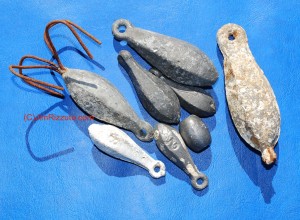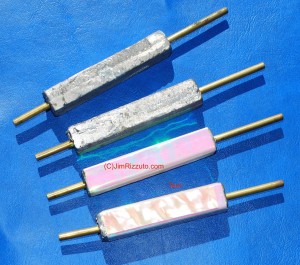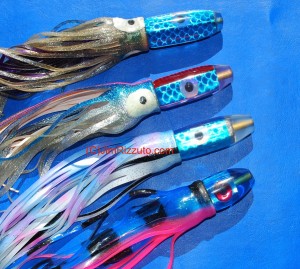The Lure-Making Tips blog is for readers who already know the techniques and methods explained in the books Lure-Making 101/102 and Lure-Making 201/202. If you don’t have these books, be sure to get them.
Lead can make a big difference in how a lure acts and how many fish it attracts. Many luremakers incorporate lead in their inserts for bullet lures and all other shapes. Caution: Melted lead can be  dangerous if you don’t follow safe handling practices. Scrap lead is especially dangerous if it has been allowed to soak in water like these salvaged sinkers were. The water penetrates the interstices in the lead, explodes when the lead is heated, and throws melted lead in all directions. If you can’t find a good source of clean lead near you, try searching eBay for “lead ingots.” I’ve found several good suppliers who sell at reasonable prices. Be sure you wear protective equipment including gloves, safety glasses and clothing. Two other safety hazards with lead: (1) Don’t breathe the fumes. Work outside in a well-ventilated site. (2) Scrub any and all lead residue off your hands so you don’t get it on your food or in your eyes.
dangerous if you don’t follow safe handling practices. Scrap lead is especially dangerous if it has been allowed to soak in water like these salvaged sinkers were. The water penetrates the interstices in the lead, explodes when the lead is heated, and throws melted lead in all directions. If you can’t find a good source of clean lead near you, try searching eBay for “lead ingots.” I’ve found several good suppliers who sell at reasonable prices. Be sure you wear protective equipment including gloves, safety glasses and clothing. Two other safety hazards with lead: (1) Don’t breathe the fumes. Work outside in a well-ventilated site. (2) Scrub any and all lead residue off your hands so you don’t get it on your food or in your eyes.
For bullet lures, I use inserts with a square cross-section like the ones shown. I wanted to decorate these with pearl laminate sheeting (www.Aquabluemaui.com) so I first wrapped the lead with fluorescent (glow in the dark) tape (glow tape). Then I attached strips cut from the laminate sheets.
I wanted to decorate these with pearl laminate sheeting (www.Aquabluemaui.com) so I first wrapped the lead with fluorescent (glow in the dark) tape (glow tape). Then I attached strips cut from the laminate sheets.
 After the lead insert is decorated in the desired pattern, it is placed in a mold and the final lure head is molded around it. After polishing and skirting, the weighted lure will run with a very fish-attracting action.
After the lead insert is decorated in the desired pattern, it is placed in a mold and the final lure head is molded around it. After polishing and skirting, the weighted lure will run with a very fish-attracting action.